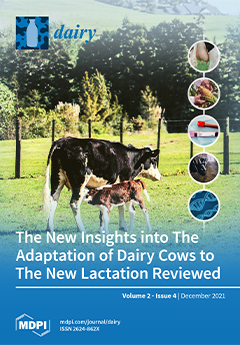The aim of this study was to investigate the distribution of cefquinome in different dairy products during the processing of naturally contaminated milk or spiked milk. The analysis of cefquinome residues in milk, skimmed milk, buttermilk, whey, cream, butter, curd, and cheese samples
[...] Read more.
The aim of this study was to investigate the distribution of cefquinome in different dairy products during the processing of naturally contaminated milk or spiked milk. The analysis of cefquinome residues in milk, skimmed milk, buttermilk, whey, cream, butter, curd, and cheese samples was performed using a water:acetonitrile solvent extraction and C
18 dispersive solid-phase extraction (d-SPE) clean-up, followed by ultrahigh-performance liquid chromatography coupled with tandem mass spectrometry (UHPLC–MS/MS) determination. The target concentration of cefquinome was achieved in the spiked milk (100 µg kg
−1). During its processing, the antibiotic migrated primarily with the skimmed milk as opposed to cream (ratios of 3.6:1 and 2.8:1 for experiments A and B, respectively), and with the buttermilk during butter manufacture (ratios of 6.9:1 and 4.6:1), but was equal in the curd and whey during the manufacture of cheese. In the milk collected from treated animals, the measured concentration of cefquinome was considerably high (approx. 5000 µg kg
−1). The results obtained from the dairy products were similar to those obtained in the spiked study (ratios of 8.2:1 and 3.1:1 for experiments A and B, respectively, during the separation of skimmed milk and cream; 6.0:1 and 5.0:1 for A and B, respectively, during the separation of buttermilk and butter). However, during cheesemaking, cefquinome migrated with the whey after cutting the curd, with ratios of 0.54:1 and 0.44:1 for experiments A and B, respectively. The difference in the migration of cefquinome between curd and whey in spiked and animal studies is probably due to the different concentration levels in the two different experiments. The results of this study showed that, in dairy products manufactured from milk containing cefquinome residues, the drug migrated primarily with the high-water-containing fractions.
Full article





